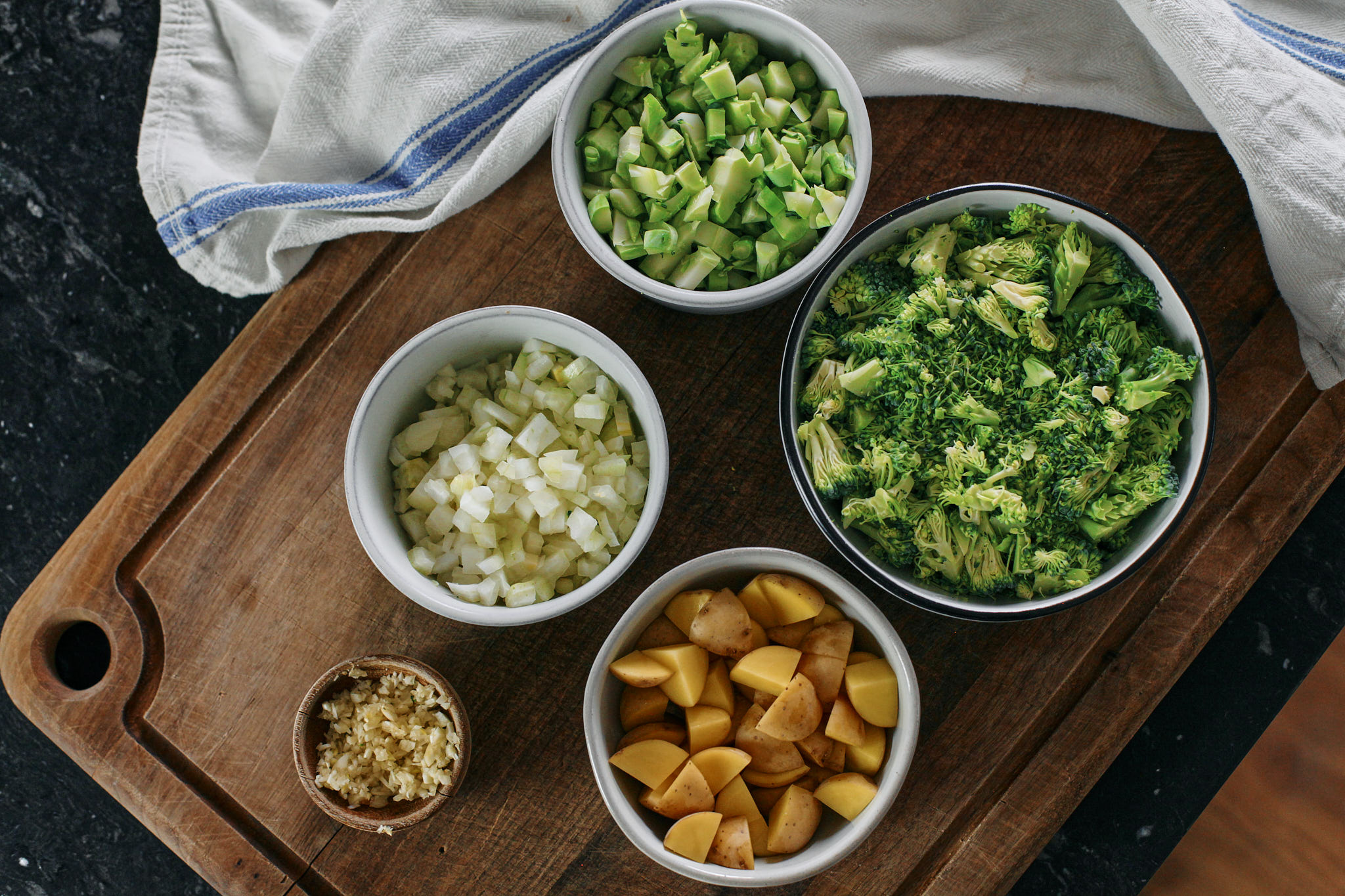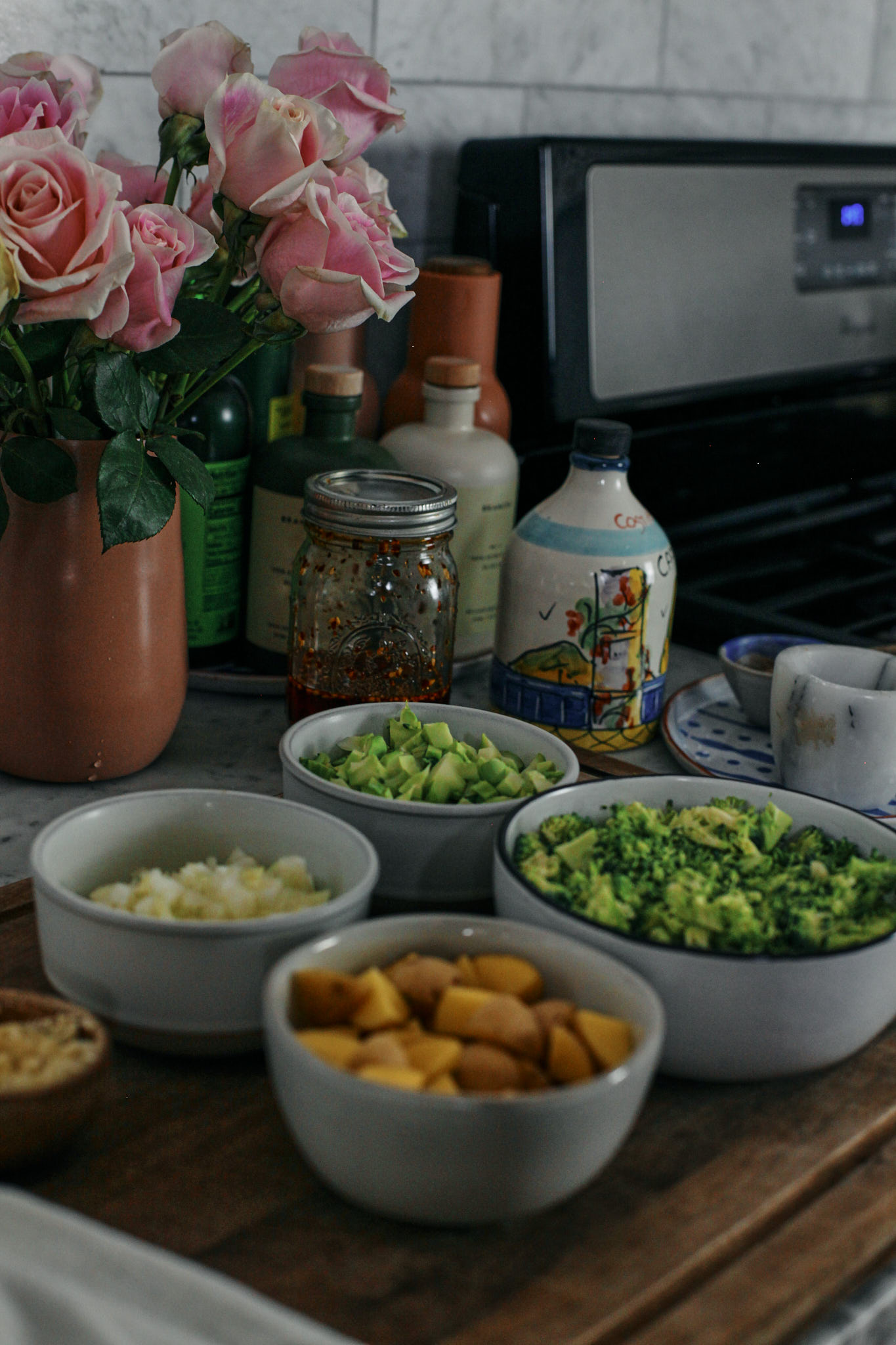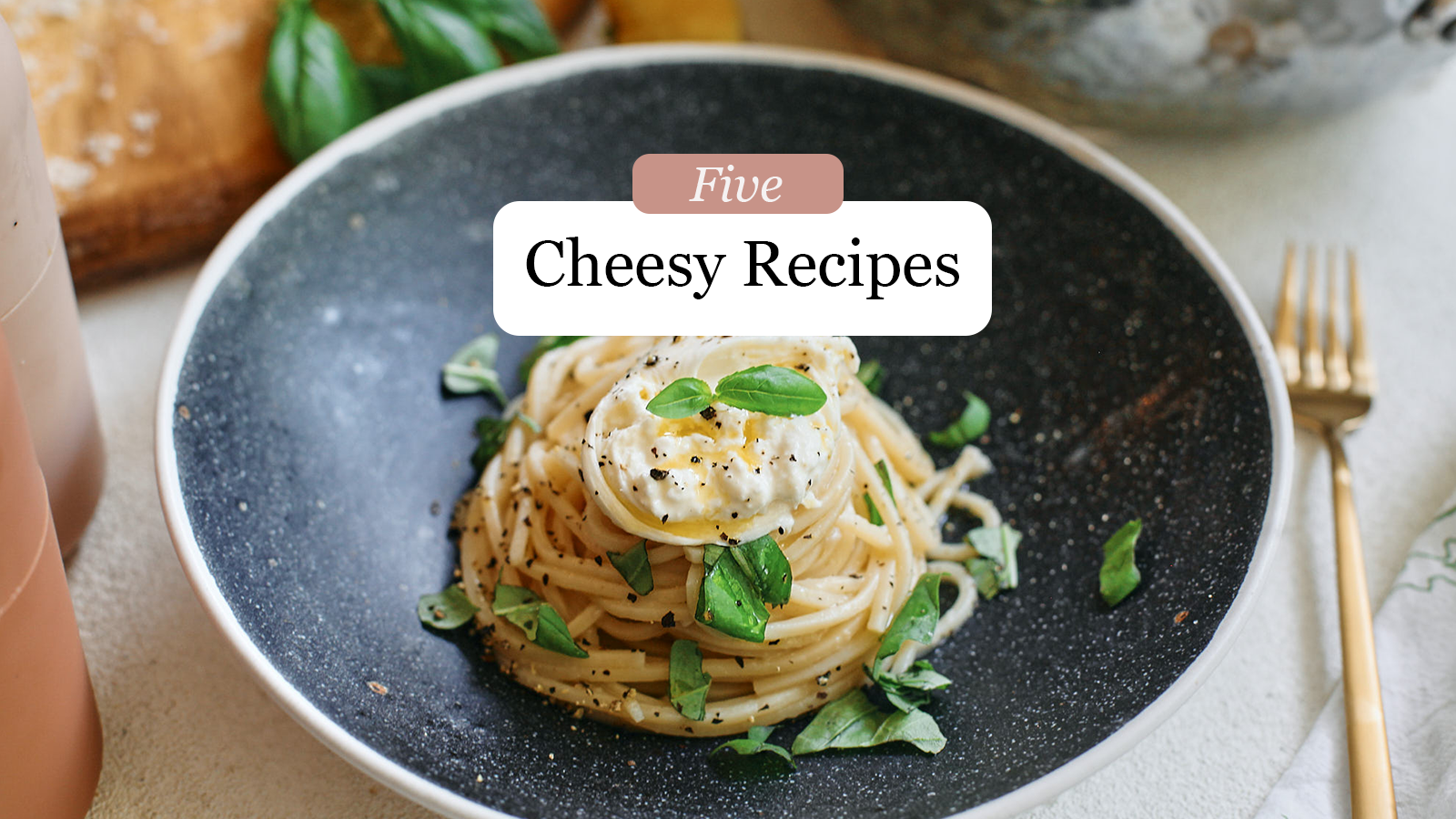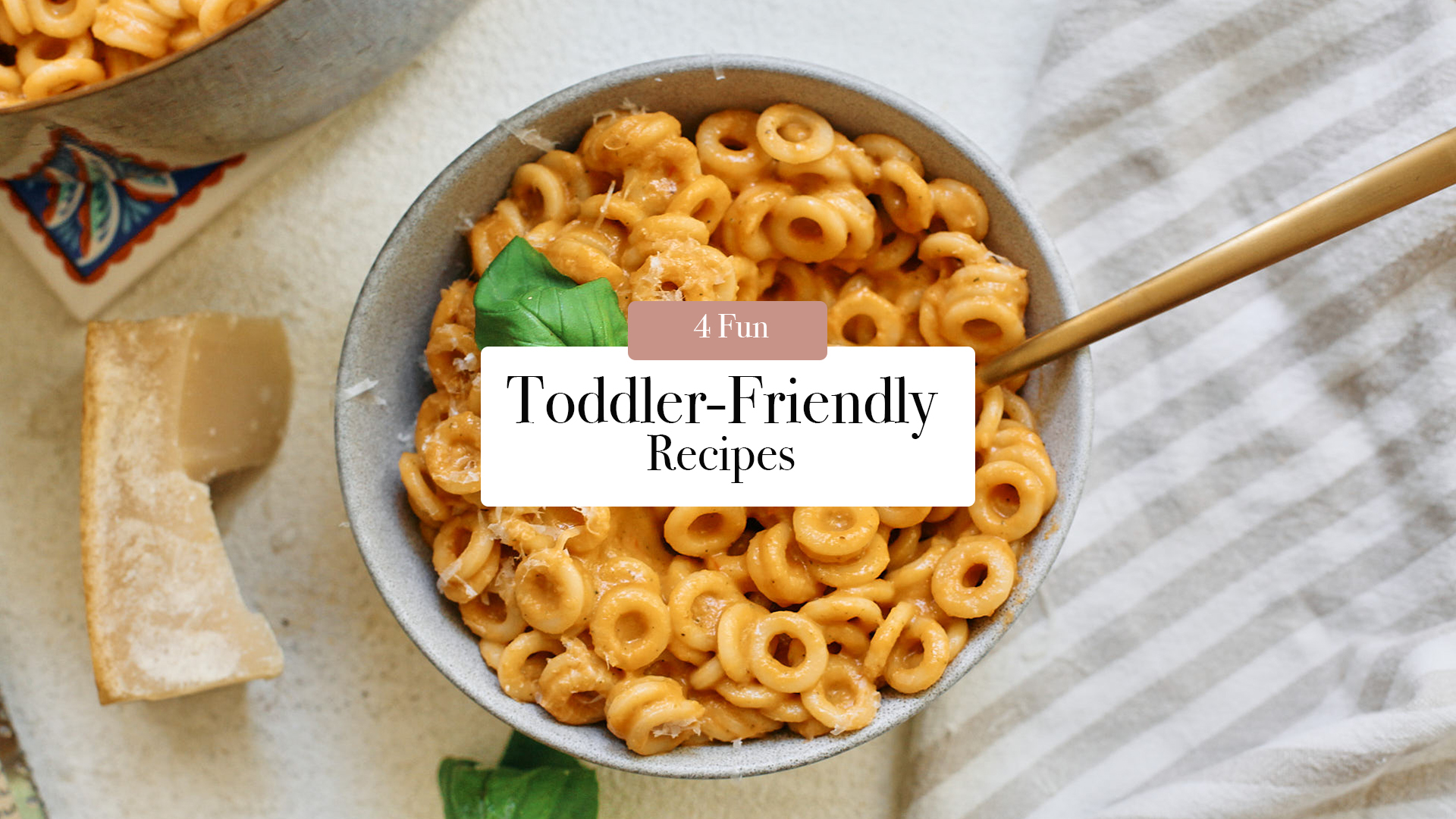Broccoli Cheddar Soup with Shells
Soups that Don’t Suck CONTINUES…
This one I am very excited about. I’ve been getting some requests for a Broccoli Cheddar Soup but this one is extra special. It has PASTA SHELLS in it and it’s perfectly creamy and has a real nostalgic feel to it.
There’s also no flour in this soup. It gets thickened by the addition of the potato, some cream, and then cooking the pasta shells directly in the soup. Trust me when I tell you that this one will be a family favourite – it’s soooo tasty.

How to make Broccoli Cheddar Soup with Shells:
Step One:
In a large pot over medium heat, add olive oil and butter until melted. Add in chopped onion and garlic and sauté for 2 minutes.
Step Two:
Add the chopped broccoli stems, chopped potato, season with salt and pepper and sauté for 4-5 minutes.

Step Three:
Add stock and water, bring to a light boil, stir, and then reduce the heat to a simmer and cook partially covered for about 10 minutes (or until stems and potato are softened when you pierce a knife through).
Step Four:
Carefully blend the soup using a blender or an immersion blender (if using a blender do this in batches). Once blended, add the soup back to the large pot and bring back to a simmer.

Step Five:
Add in the medium size pasta shells and cook according to package instructions (note that it may take longer since you’re cooking on a lower heat and not in boiling water).
Step Six:
Once the shells are al dente, add in the very finely chopped broccoli florets. These will cook very quickly (roughly 3-4 minutes), continue to stir.
Step Seven:
Turn the heat off, add in heavy cream and grated cheddar cheese. Stir well to combine and serve. Option to add more grated cheese at the end!

What type of Potatoes to use for Broccoli Cheddar Soup with Shells:
I’d recommend using a high starch potato for this soup! For example, Idaho or Russet potatoes. These potatoes are ideal for making creamy soups – they break down more easily when cooked, which can naturally thicken the soup, giving it a creamy texture!
What type of Cheese to use for Broccoli Cheddar Soup with Shells:
Highly recommend against using a pre-shredded cheese for this soup. A few reasons why below:
- Pre-shredded cheese is coated with anti-caking agents like cellulose or cornstarch to prevent the shreds from clumping together in the bag. These additives can mess with the cheese melting smoothly in the soup, potentially leading to a grainy or less cohesive texture.
- The moisture content of pre-shredded cheese can be higher due to the anti-caking agents, affecting how it melts and integrates into the soup.
- Pre-shredded cheeses may not have the same depth of flavor as a block of cheese that you shred yourself, especially if you’re using a high-quality cheddar. Freshly shredded cheese tends to melt better and distribute more evenly, giving the soup a more consistent and rich cheese flavor.
For the best results in your broccoli cheddar soup, I’d recommend buying a block of high-quality sharp or extra-sharp cheddar cheese and shred it yourself just before adding it to the soup. This extra step can really make the soup high quality!

How to Store Broccoli Cheddar Soup with Shells:
Just let the soup cool down after cooking, then transfer it to an airtight container. It can be stored in the refrigerator for up to 3 days or frozen for up to 2 months. To reheat, thaw overnight in the refrigerator if frozen, then warm on the stove over medium heat, stirring occasionally. If the soup is too thick, a little stock or water can be added to reach your desired consistency.
Freezing for Long-Term Storage
Freezing is an excellent way to extend the life of your soup, but it does require a bit of strategy, especially because of the pasta shells. Pasta, when frozen in soups, can become mushy upon reheating. To avoid this, you could try a couple of approaches:
- Freeze Without Pasta: One effective method is to prepare and freeze the soup without adding the pasta shells. When you’re ready to enjoy the soup, simply thaw it overnight in the refrigerator, heat it up, and cook the pasta shells separately to add them to the soup just before serving. This ensures the pasta maintains its texture and doesn’t absorb too much liquid during the freezing and thawing process.
- Undercook Pasta for Freezing: If you prefer to freeze the soup with the pasta included, consider undercooking the pasta shells slightly before adding them to the soup. This can help mitigate the texture changes during freezing and reheating, as the pasta will finish cooking when you reheat the soup.

Broccoli & Cheddar Soup with Shells
Ingredients
- 1 head broccoli florets and stems separated (florets chopped very finely)
- 1 medium or large potato chopped
- 1 medium onion chopped
- 3 cloves garlic chopped
- 2 tbsp olive oil
- 2 tbsp butter
- salt & pepper
- 4 cups stock
- 4 cups water
- 2 cups medium pasta shells
- 3/4 cup heavy cream
- 1.5 cups cheddar cheese grated
Instructions
- In a large pot over medium heat, add olive oil and butter until melted. Add in chopped onion and garlic and sauté for 2 minutes.
- Add the chopped broccoli stems, chopped potato, season with salt and pepper and sauté for 4-5 minutes.
- Add stock and water, bring to a light boil, stir, and then reduce the heat to a simmer and cook partially covered for about 10 minutes (or until stems and potato are softened when you pierce a knife through).
- Carefully blend the soup using a blender or an immersion blender (if using a blender do this in batches). Once blended, add the soup back to the large pot and bring back to a simmer.
- Add in the medium size pasta shells and cook according to package instructions (note that it may take longer since you're cooking on a lower heat and not in boiling water).
- Once the shells are al dente, add in the very finely chopped broccoli florets. These will cook very quickly (roughly 3-4 minutes), continue to stir.
- Turn the heat off, add in heavy cream and grated cheddar cheese. Stir well to combine and serve. Option to add more grated cheese at the end!











I made this tonight. I like the addition of pasta and potato, although next time I will either put a cup less liquid or I will thicken it up because it was quite thin. I followed all the measurements but still not very thick. And added more cheese as well. Other than that was a nice soup, thanks!
I’d recommend a soup that uses a roux as opposed to doing it this way, and cut the liquid used here at least by half. I wanted to try this as a shorter way to make this. Soup had zero creaminess and the cheese doesn’t stir in well, it just clumped and sunk to the bottom. Also, fairly flavourless so would definitely add additional seasoning if you’re going to make this.
1) A tablespoon of corn starch thickens it right up if you want it thicker.
2) Don’t use bagged shredded cheese or it clumps from the additives in it.
Hey there! Were you using pre-shredded cheese by chance? I’d definitely recommend grating the cheese yourself as there is an anti-caking agent that coats the cheese for the pre-shredded kind, preventing it from really blending into the soup. It also could be potatoes – try using a high starch potato like russets or idaho as that can add to the creaminess of the soup as well. Thanks so much for your comment! I’m going to update the blog post with some more tips for this issue 🙂
This review is spot on. Flavorless. Lumpy cheese (not pre shredded). Runny. Gross.
I’ve made this twice and it turned out fine. Maybe you just suck at cooking? Ever think that might be the issue?
For those saying it’s thinner than their liking, I made a little slurry with 1 1/3 Tbs of corn starch and it thickened right up! Great recipe!
I made this without the pasta and it was very thin. I think I will try again, but maybe only use 1 cup of water instead of 4. I also shredded my own cheese and it was still really clumpy.
Hey Kyle! The liquid in the recipe is accounting for cooking the pasta directly in the soup. The starch from the pasta definitely helps to thicken it! I’d recommend reducing the liquid if you’re not using the pasta.
Hello! I am wondering if this recipe could be made using a slow cooker? What changes would need to be made?
Delicious fresh, and even better warmed up the next day! I followed the recipe as written, onions omitted, and it turned out great.
This turned out great after a few modifications. First, I added only three cups of water instead of four after reading the reviews that said it was watery. I had to cook the broccoli stems and potatoes for 20-25 minutes instead of the 10 listed. I added more cheese (but that’s just a personal preference) and whisked it in to ensure it didn’t clump like others experienced. I will definitely be making this again!